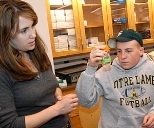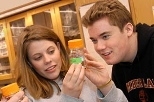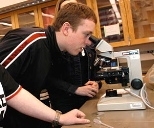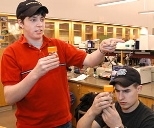MIT Nobel laureate H. Gobind Khorana relayed the recipe for India ink to 18 rapt biology honors 10th-graders Monday as part of an hour-long discussion that touched on his childhood village, where his school consisted of mats under a wooden box in the shade. The makeshift blackboard was a clay-coated wooden board scratched with a pen made from a stalk of sugarcane.
This group of students on a science field trip to MIT also heard Khorana, the Alfred P. Sloan Professor Emeritus, describe his groundbreaking work on unlocking of DNA's genetic code, while others of the 80 who attended from Arlington, Hudson, Holliston, Lexington and Dedham observed zebrafish embryo development or analyzed protein structure with laptops on loan from the physics department. The fourth group learned how microscopy and time-lapse digital photography could be combined to view axon growth in live neurons.
The four groups came together to hear Eric Lander, professor of biology and director of the MIT/Whitehead Genome Center, sum up the past century's progress in understanding the human genome--a century that started with Mendel's idea that "packets of information" are handed down from one generation to the next, and ended with an almost complete inventory of every human gene. The students were intrigued by Lander saying that he could, with saliva samples, determine which handful of students in the audience was at risk for Alzheimer's disease or which were carriers of cystic fibrosis.
The group also heard Susan Lindquist, professor of biology and director of the Whitehead Institute for Biomedical Research, describe the ability of shape-shifting proteins to cause mad cow disease.
"The field trip to MIT was organized in part to answer a need expressed by science teachers," said biology instructor Mandana Sassanfar, who organizes summer programs that connect local students and teachers with MIT. In fact, the need was a little overwhelming. The activity was originally planned for 40 students and extended to 80, while another 90 had to be turned away.
"Bringing high school students to an institution such as MIT and giving them the opportunity to meet and speak with internationally renowned scientists and interact with graduate students, postdocs and instructors is a very important and inspiring experience for many of the students, especially the younger ones," Sassanfar said.
"In addition, the hands-on activities offered to the students during the field trip are very difficult to organize in a high school setting, but are very relevant to the high school science curriculum," she said.
The science field trip was supported in part by the Howard Hughes Medical Institute (HHMI). One of the activities made possible by HHMI is a special group in Professor Graham C. Walker's laboratory that works on educational issues, with a focus on teaching introductory biology.
Walker, who welcomed the high school students and helped arrange the discussion with the usually reticent Khorana, hooked up with Sassanfar because of her experience with high school outreach. She also will organize a week-long biology workshop for high school teachers this summer.
"This field trip was our first activity that directly involved high school students and I feel sure that we will be doing it again," Walker said. "Judging from the reaction of the students and teachers, I think it was very successful. We learned some things from this year's experiment that should allow us to make it even better in the future."









